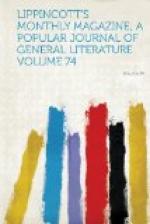“that
infinity with which my wife
Was dearer to my soul than its soul-life.”
Mrs. Richardson’s notes, in fact, contradict the impression of thoroughness which her selecting, we are glad to say, leaves on the mind. She is aware that the “Ode to Melancholy” in The Nice Valour begins in the same way as Milton’s “Pensieroso,” but she does not seem to know that the latter is also closely imitated from Burton’s poem in his Anatomy of Melancholy. And she quotes John Still’s “Jolly Good Ale and Old” as a “panegyric on old sack,” sack being sweet wine.
The publishers have done their part, and made of these drops of oozed gold what is called “an elegant trifle” for the holidays. Mr. John La Farge, a very “advanced” sort of artist and illustrator, has furnished some embellishments which will be better liked by people of broad culture, and especially by enthusiasts for Japanese art, than they will be by ordinary Christmas-shoppers, though the frontispiece to “Songs of Fairies,” representing Psyche floating among water-lilies, is beautiful enough and obvious enough for anybody.
Books Received.
A Concordance to the Constitution of the United States
of America. By
Charles W. Stearns, M.D. New York: Mason,
Baker & Pratt.
The Standard: A Collection of Sacred and Secular
Music. By L.O.
Emerson and H. R. Palmer. Boston: Oliver
Ditson & Co.
Gems of Strauss: A Collection of Dance Music
for the Piano. By Johann
Strauss. Boston: Oliver Ditson & Co.
The Greeks of To-Day. By Charles K. Tuckerman.
New York: G.P. Putnam &
Sons.
The Eustace Diamonds. By Anthony Trollope.
New York: Harper &
Brothers.
How to Paint. By F.B. Gardner. New York: Samuel R. Wells.



